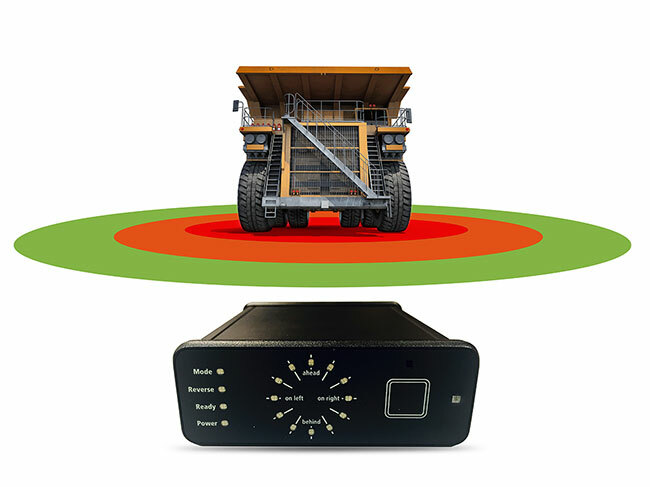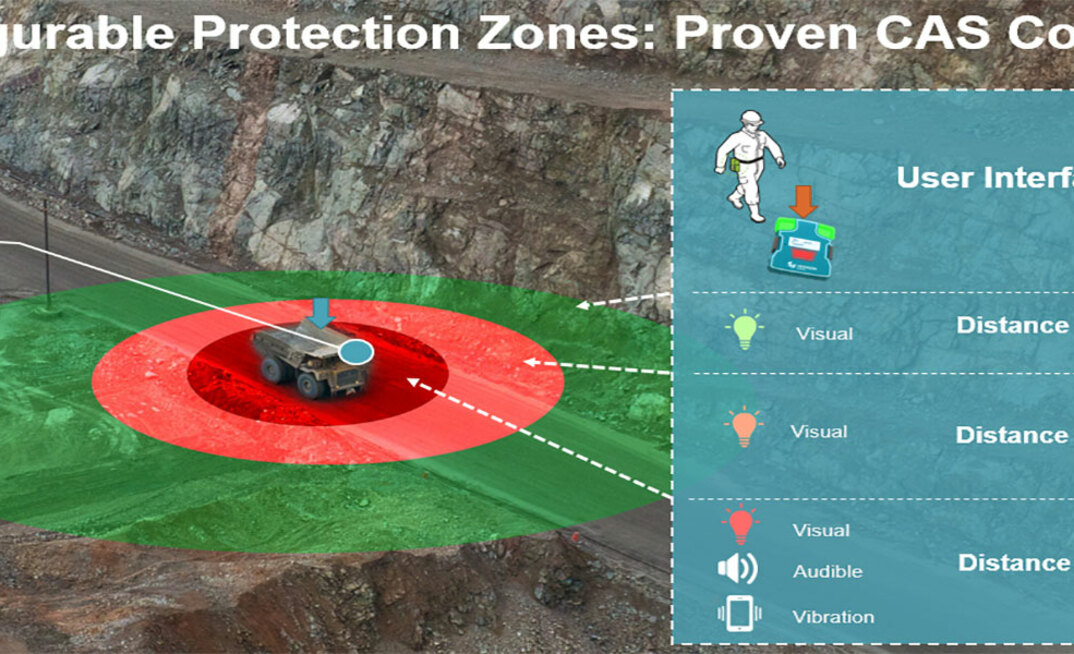Noise, distraction, poor visibility and fatigue are daily hazards for mining equipment operators. At our annual digital solutions conference, HxGN LIVE in Las Vegas, June 11-14, you can experience these conditions for yourself in our cabin simulator. See how an integrated safety solution addresses these dangers to ensure that everyone gets home safely.
Collisions involving equipment concern all mining operations. Usually these incidents result in damage and downtime for repairs. However, severe incidents can involve injuries and even loss of life.
The financial cost of collisions illustrates the potential return on investment of avoiding just one major incident. The cost of a serious injury or fatality is more difficult to quantify. Long after the formal investigation is complete, workers, families, communities, and the mining company continue to feel the effects. The benefits of avoiding such incidents are hard to gauge, as are other benefits, such as increased productivity, competitiveness, and profitability.
New legislation reflects these concerns. Rules are proposed in many countries that will require collision avoidance technology at mine sites.
All of these factors occur against the backdrop of a highly competitive industry. Under increasing pressure to identify and exploit new reserves, reduce costs, and boost productivity, mines must also improve safety. Are all these competing interests compatible?
The art of mining is to balance safety and productivity. Success today depends on improving both. Integrated solutions are helping to ensure that this is possible.
Technologies from Hexagon are helping to prevent incidents while improving efficiencies and increasing productivity. Studies undertaken by Hexagon and feedback to its technology have determined the effectiveness of existing systems, the costs associated with implementation, and the long-term benefits for mining operations.
Committing to a safety portfolio that integrates a collision avoidance system with fatigue monitoring, personal protection, tracking radar and vehicle intervention might be the smartest investment a mine can make.

HxGN MineProtect Collision Avoidance System is used in more than 30,000 vehicles worldwide.
Bringing safety down to earth
Hexagon's MineProtect safety portfolio traces its origins to the Swiss Alps and avionics. A few skillful engineers and enthusiastic glider pilots designed a system to avoid collisions between glider planes. The system had to work in all three dimensions of space.
With little sight around the cockpit, glider pilots tend to fly in close proximity, chasing thermal upwinds. Collisions are rare but can end tragically. The first collision avoidance system was built and became the standard for light aircraft in Swiss airspace and beyond.
When a mine manager from AngloAmerican approached the entrepreneurs about a collision-avoidance solution for a mine in South Africa, they responded by building a collision avoidance system (CAS). CAS tackles blind spots, one of the leading causes of incidents in the industry. Today it anchors Hexagon's safety portfolio and is used in more than 30,000 vehicles worldwide.
HxGN MineProtect CAS gives vehicle operators 360-degree proximity detection at any speed and in all conditions via unobtrusive cabin display units. For operators, CAS represents peace of mind. It helps operators work more confidently and productively, especially in poor visibility caused by rain, snow, and fog. It also helps at night when the system becomes invaluable, helping drivers to work more smoothly and efficiently.

360-degree proximity detection at any speed and in all conditions via unobtrusive cabin display units provides peace of mind for operators using HxGN MineProtect Collision Avoidance System.
The benefits of CAS can be dramatic.
"I was driving along in a light vehicle and came to an intersection, looked both ways, didn't see anything, so I started to accelerate," recalls Martin Leggat, a mine surveyor for New Hope Group's Acland Mine in Queensland, Australia.
"Then CAS went off and alerted me that a vehicle was coming and within a second there was a big 793 dump truck coming down on me. The system basically saved me."
Mines using CAS report a reduction in collisions. The Premier Mine in Western Australia, for instance, reported a 53% reduction in metal-to-metal contacts within the year following implementation of CAS.
Another large mining company in Australia reported its results at the 2014 Queensland Mining Industry Health & Safety Conference. In the 12 months that preceded CAS implementation, the mine experienced 14 machine-to-machine incidents. After CAS was implemented, there were only two incidents during the next two years. The first involved a rented dozer that was not fitted with CAS, thus, the other vehicle was not able to detect this dozer. In the second incident, the system alerted the operator, but he failed to take evasive action.
An underground silver mine in the U.S. uses CAS to address a uniquely challenging issue facing its staff. Employees must share a 19-kilometer, single-lane access road with ore haulage and freight trucks to reach the mine site. Blind corners, darkness, fog, heavy snow, and bridges on a single-lane road are just some of the challenges employees face.
The company needed a system to alert drivers to approaching vehicles out of their line of sight and as far away as 300 meters to give them sufficient time to react. No data communications infrastructure was available along the haulage road. Peer-to-peer notification between vehicles was required.
To give drivers notice of another vehicle ahead, CAS now provides voice announcements. At a pre-set detection distance of 300 meters, an announcement is given in the driver's cab, indicating the type of vehicle approaching. LED indicators show the direction to the other vehicle and provide the distance by changing color - green for 300-100 m, red for 100-10 m, and flashing red for closer than 10 m.

Making sure everyone gets home safely with HxGN MineProtect CAS.
The mine was awarded the National Institute for Occupational Safety and Health (NIOSH) Mine Safety and Health Technology Innovations Award for implementing CAS.
Mines can use such data and the improved safety record to negotiate lower insurance premiums, further reducing cost. A major mine in South America showed that 98% of its 521 operators believed that CAS is a useful tool for keeping them and their colleagues safe. Further, 97% say that the information presented by CAS is sufficient and easy to interpret.
Integrated with CAS is HxGN MineProtect Tracking Radar, which delivers real-time tracking and reporting functionality to help improve operator behavior. Tracking Radar works via a web-based interface, customized reports, and configurable text messages and email alerts. Mines find Tracking Radar to be effective in keeping vehicle speeds under required limits.
Using area definitions, speed limits can be adjusted for different areas of the mine. For instance, haul roads can differ from access roads. A demonstration at a Canadian coal mine revealed a 54% reduction in all over-speed events in the mine, and a 100% reduction in events where vehicle speed was 10 kph over the speed limit.
Reduction in costs and downtime associated with collisions is an added benefit to the safety improvements realized through these systems. A single accident with no injuries can limit machine availability and put mining operations on hold for days. The resulting repair costs, equipment downtime, administrative requirements, and lost productivity all impact the bottom line. Quantifying the comparative success of safety technology is difficult, because mining operators are notoriously reluctant to disclose such data. Safety is a sound investment but sometimes decision-makers are unaware of accidents prevented by such technology.
ROI (return on investment) analysis makes a compelling case for investment in collision avoidance. Hexagon researched three potential scenarios, which are summarized here.
If a medium-sized mine averages one non-injury backing accident per year involving two haul trucks, total cost could be $4.3 million over five years. The total investment for CAS technology over five years is $1.8 million. The technology potentially eliminates these types of accidents so the total savings to the mine is potentially $2.5 million over the same period. The ROI is calculated as ($4.3M - $1.8M)/1.8M = 1.4 or 140%.
A second scenario documents an accident resulting in a fatality. With potential costs approaching $20 million, the benefits of eliminating a collision that relates to a fatality are obvious. However, this serves to illustrate that investment in collision avoidance or a fatigue monitoring system makes financial as well as moral sense.
In the final example, CAS's speed monitoring and alarming functions reduce over-speed events by 90%. This results in a cost savings of $1.85 million over five years, including two avoided collisions. With the investment in CAS, the mine breaks even in approximately five years (ROI=0.03), or less if other incidents are avoided.
For all mines, accommodating the pressure for productivity with the need for safety is a fine balance. Hexagon believes safety solutions that put people first need not be at the expense of efficiency and results. CAS's integration with Hexagon's solutions for fleet management, vehicle intervention, fatigue monitoring and personal protection make it one of the most comprehensive safety portfolios on the market: a powerful ally for any mine pursuing zero harm and an important part of ensuring that everyone gets home safely.
ABOUT THIS COMPANY
Hexagon Mining
Hexagon’s Mining division brings surveying, design, fleet management, production optimization, and collision avoidance together in a life-of-mine solution that connects people and processes.
HEAD OFFICE:
- 40 East Congress Street, Suite 300, Tucson, Arizona, 85701, United States
- Phone: +1 520 795 3891
- Web: hexagonmining.com


























